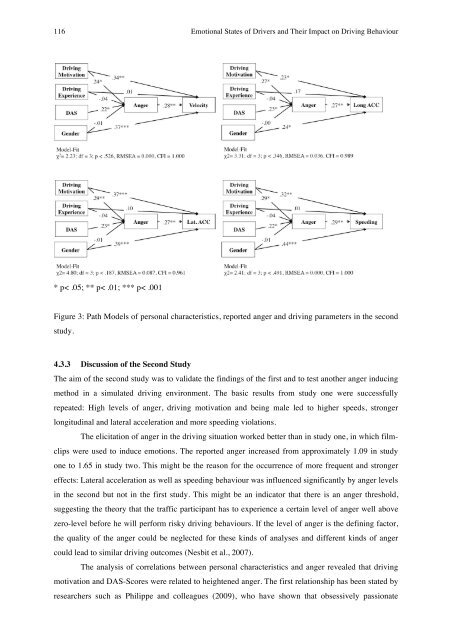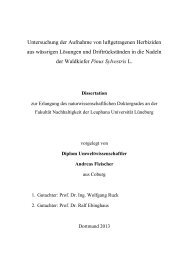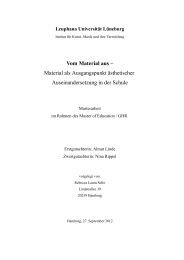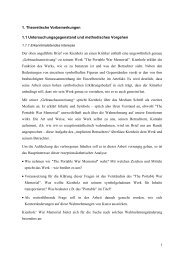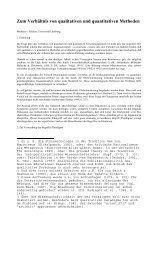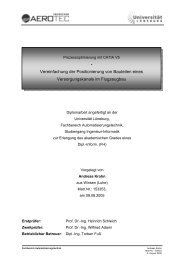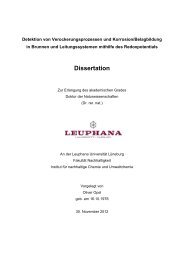Determinants of Emotional Experiences in Traffic Situations ... - OPUS
Determinants of Emotional Experiences in Traffic Situations ... - OPUS
Determinants of Emotional Experiences in Traffic Situations ... - OPUS
You also want an ePaper? Increase the reach of your titles
YUMPU automatically turns print PDFs into web optimized ePapers that Google loves.
116 <strong>Emotional</strong> States <strong>of</strong> Drivers and Their Impact on Driv<strong>in</strong>g Behaviour!<br />
* p< .05; ** p< .01; *** p< .001<br />
Figure 3: Path Models <strong>of</strong> personal characteristics, reported anger and driv<strong>in</strong>g parameters <strong>in</strong> the second<br />
study.<br />
4.3.3 Discussion <strong>of</strong> the Second Study<br />
The aim <strong>of</strong> the second study was to validate the f<strong>in</strong>d<strong>in</strong>gs <strong>of</strong> the first and to test another anger <strong>in</strong>duc<strong>in</strong>g<br />
method <strong>in</strong> a simulated driv<strong>in</strong>g environment. The basic results from study one were successfully<br />
repeated: High levels <strong>of</strong> anger, driv<strong>in</strong>g motivation and be<strong>in</strong>g male led to higher speeds, stronger<br />
longitud<strong>in</strong>al and lateral acceleration and more speed<strong>in</strong>g violations.<br />
The elicitation <strong>of</strong> anger <strong>in</strong> the driv<strong>in</strong>g situation worked better than <strong>in</strong> study one, <strong>in</strong> which filmclips<br />
were used to <strong>in</strong>duce emotions. The reported anger <strong>in</strong>creased from approximately 1.09 <strong>in</strong> study<br />
one to 1.65 <strong>in</strong> study two. This might be the reason for the occurrence <strong>of</strong> more frequent and stronger<br />
effects: Lateral acceleration as well as speed<strong>in</strong>g behaviour was <strong>in</strong>fluenced significantly by anger levels<br />
<strong>in</strong> the second but not <strong>in</strong> the first study. This might be an <strong>in</strong>dicator that there is an anger threshold,<br />
suggest<strong>in</strong>g the theory that the traffic participant has to experience a certa<strong>in</strong> level <strong>of</strong> anger well above<br />
zero-level before he will perform risky driv<strong>in</strong>g behaviours. If the level <strong>of</strong> anger is the def<strong>in</strong><strong>in</strong>g factor,<br />
the quality <strong>of</strong> the anger could be neglected for these k<strong>in</strong>ds <strong>of</strong> analyses and different k<strong>in</strong>ds <strong>of</strong> anger<br />
could lead to similar driv<strong>in</strong>g outcomes (Nesbit et al., 2007).<br />
The analysis <strong>of</strong> correlations between personal characteristics and anger revealed that driv<strong>in</strong>g<br />
motivation and DAS-Scores were related to heightened anger. The first relationship has been stated by<br />
researchers such as Philippe and colleagues (2009), who have shown that obsessively passionate


